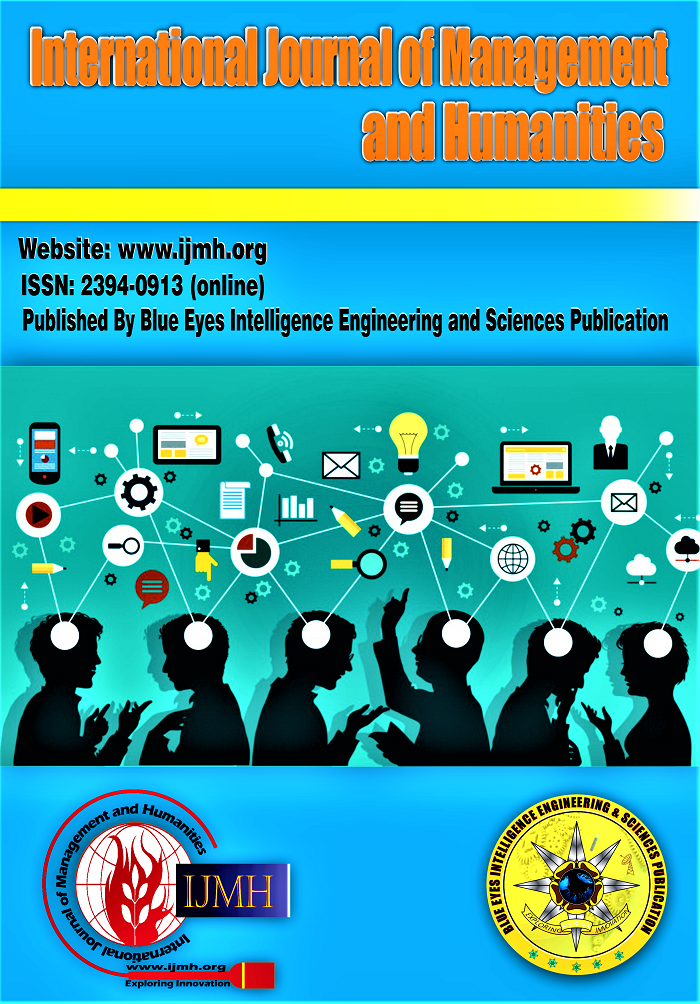A Study on Gender Gap in Financial Inclusion with Special Reference to Kancheepuram District
Main Article Content
Abstract
Financial inclusion is defined as availability of financial services to a large segment of the population at a reasonable cost, such as savings, investment, borrowing, insurance and pension etc., to vast section of society at affordable cost. The essence of financial inclusion is to ensure delivery of various financial services, such as savings bank accounts for savings and transactions, availability of low-cost credit, and insurance and pension services. The main objective of this paper is to analyze the gender gap in financial inclusion. The primary data have been collected from Kancheepuram district of Tamil Nadu. The sample size for the study is 480. The findings of the study shows that the Financial Inclusion Gender Gap in Kancheepuram District is much higher than that of other parts of the country, both in banking and non-banking segments.
Downloads
Article Details
Section
How to Cite
References
Aduda, J., and Kalunda, E. Financial inclusion and financial sector stability with reference to Kenya: A review of literature. Journal of Applied Finance and Banking, (2012) 2(6), pp. 95-120.
Alamelu K. Financial Inclusion Gender Gap. Indian Banker, The Monthly Journal Published by the Indian Banks’ Association, September 2017, 40-45.
Available at: www.theindianbanker.co.in
Allen, F., Carletti, E., Cull, R., Qian, J.Q., Senbet, L., and Valenzuela, P. The African Financial Development and Financial Inclusion Gaps. Journal of African Economies. (2014) Available at: DOI:10.1093/jae/eju015 https://doi.org/10.1093/jae/eju015
Arnold, J., and Gammage, S. Gender and Financial Inclusion: The Critical Role for Holistic Programming. Development in Practice, (2019)29(8), pp. 965-973, ISSN: 0961-4524. Available at: https:// doi.org /10.1080 /09614524.2019.1651251.
Arun, T., and Kamath, R. Financial Inclusion: Policies and Practices. IIMB Management Review, . (2015). 27(4), pp. 267-287.
Available at: http://doi.org/10.1016/j.iimb.2015.09.004. https://doi.org/10.1016/j.iimb.2015.09.004
Bentler, P. M.Some Contributions to Efficient Statistics in Structural Models: Specification and Estimation of Moment Structures. Psychometrika, (1983) 48(4), pp. 493-517. https://doi.org/10.1007/BF02293875
Bijoy, K. Financial inclusion in India and PMJDY: A critical review. Proceedings of the First International Conference on Information Technology and Knowledge Management, ICITKM .(2017)14, pp. 39-46. https://doi.org/10.15439/2017KM32
Botric, V., and Broz, T. Gender differences in financial inclusion: Central and South Eastern Europe. South-Eastern Europe Journal of Economics, (2017) 15(2), pp. 209-227.
Browne, M. W. and Cudeck, R. Alternative Ways of Assessing Model Fit. In: K. Bollen& J. S. Long (Eds.). Testing Structural Equation Models, Newbury Park: Sage Publications, (1993)pp.136-162.
Charan, K.Y., and Prashanthi, K. A Study on Fixed Deposit Schemes in Selected India: A Comparative Study. Journal of Emerging Technologies and Innovative Research, (2020) 7(8), pp. 53-56, ISSN 2349-5162.
Available at: www.jetir.org
Chavan, J. Internet Banking – Benefits and Challenges in an Emerging Economy. International Journal of Research in Business Management, (2013) 1(1), pp. 19-26.
Chen, Z., and Garand, J.C. On the Gender Gap in Financial Knowledge: Decomposing the Effects of Don’t Know and Incorrect Responses. Southwestern Social Science Association, (2018), 99(5), pp.1551-1571. https://doi.org/10.1111/ssqu.12520
Available at: https://www.researchgate.net/publication/322949838.
Choithrani, S. Financial inclusion: need of the hour. International Journal of Management Research and Reviews, (2013). 3(9), pp.3565-3568.
Cull, R., Demirguc-Kunt, A., and Morduch, J. Microfinance Meets the Market. Journal of Economic Perspectives, (2009), 23(1), pp. 1-50. https://doi.org/10.1257/jep.23.1.167
Damodaran, A. Financial inclusion: Issues and Challenges. AKGEC International Journal of Technology, (2013). 4(2), pp. 54-59.
Daniel, E. Provision of Electronic Banking in the UK and the Republic of Ireland. International Journal of Bank Marketing, (1999), 17(2), pp. 72-82. https://doi.org/10.1108/02652329910258934
Friedline, Terri. A Development Perspective on Children’s Economic Agency. Journal of Consumer Affairs. (2015). https://doi.org/10.1111/joca.12062
Available at: doi:10.1111/joca.12062. https://doi.org/10.1111/joca.12062
George. O., et. Al. Social Capital: Mediator of Financial Literacy and Financial Inclusion in Rural Uganda. Review of International Business and Strategy, (2016), 26(2), pp. 291-315.) https://doi.org/10.1108/RIBS-06-2014-0072
Marsh, H. W. and Grayson, D. Latent Variable Models of Multi-Trait-Multi-Method Data. In: R. Hoyle (Ed.). Structural Equation Modeling: Concepts, Issues and Applications, Thousand Oaks, CA: Sage, (1995) pp. 177-198. https://doi.org/10.1080/10705519509540012
Mathieu, R.D., Terri, F. and Stacia, M.W. Why Do Households Lack Emergency Savings? The Role of Financial Capability. Journal of Family and Economic (2020). Issues, 41, pp. 542-557. https://doi.org/10.1007/s10834-020-09679-8
Available at: http://doi.org/10.1007/s10834-020-096798.
Matin, I.D., Hulme and Rutherford, S. Finance for the Poor: From Microcredit to Micro Financial Services. Journal of International Development, (2002), 14(2), pp. 273-294. https://doi.org/10.1002/jid.874
McDonald, R. P. and Ho, M. H. R. Principles and Practice in Reporting Structural Equation Analyses. Psychological Methods, (2002) ,7(1), pp. 64-82. https://doi.org/10.1037//1082-989X.7.1.64
Md.Sapir, A., Md. Shafik, and Ahmad, W.M.W. Financial Literacy among Malaysian Muslim Undergraduates. Journal of Islamic Accounting and Business Research, Emerald Publishing Limited, 1759-0817. (2019), Available at: DOI 10.1108/JIABR-10-2017-0149.
Meshram, P.P., and Randad, A. A Survey and Study on Awareness of Financial Inclusion in an Around Pune City, Pune. International Journal of Engineering Technology, Management and Applied Sciences, (2015). Vol. 3. Available at: www.ijetmas.com.
Mudzingiri, C., John W.M.M. and Jacobus, N.K. Financial Behavior, Confidence, Risk Preferences and Financial Literacy of University Students. Cogent Economics & Finance, (2018), 6(1). Available at: DOI: 10.1080/23322039.2018.1512366. https://doi.org/10.1080/23322039.2018.1512366
Hassan, Mr. R. A. A. (2023). Examining the Financial Inclusion Index to Determine the Financial Inclusion Status in India. In Indian Journal of Economics and Finance (Vol. 3, Issue 1, pp. 8–14). https://doi.org/10.54105/ijef.b2559.053123
Shithii, I. J., & Akter, Most. S. (2024). Financial Inclusion through Fin-tech Adoption of Women: A Way to Sustainable Development. In International Journal of Management and Humanities (Vol. 10, Issue 5, pp. 10–16). https://doi.org/10.35940/ijmh.e1685.10050124
Das, Mr. G. S., & Nayak, Prof. (Dr.) B. (2020). Financial Inclusion: An Application of Machine Learning in Collaborative Filtering Recommender Systems. In International Journal of Recent Technology and Engineering (IJRTE) (Vol. 8, Issue 6, pp. 4243–4247). https://doi.org/10.35940/ijrte.f9361.038620
Bhuvana, Dr. M., & Vasantha, Dr. S. (2019). An Outlook of Financial Inclusion with Mediating Effect of Direct Benefit Transfer in LPG Subsidy towards Actual Usage of Banking Technology. In International Journal of Engineering and Advanced Technology (Vol. 8, Issue 6s, pp. 804–811). https://doi.org/10.35940/ijeat.f1153.0886s19
Financial Inclusion, Awareness, and Understanding of Financial Products among People Selected Gewogs (Blocks) of Bhutan. (2019). In International Journal of Innovative Technology and Exploring Engineering (Vol. 8, Issue 11S2, pp. 485–494). https://doi.org/10.35940/ijitee.k1081.09811s219





